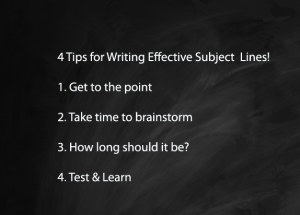 We’ve all done it. You’ve put together a killer email with tight messaging, sharp graphics, a strong call-to-action, and a landing page that’s optimized and ready to convert. Now it’s time to write the dreaded subject line, the most important and most difficult part of the process. We all know that the subject line can make or break an email, a great subject line boosts open rates, and when everything else is in place it ultimately leads to more conversions. So why do so many marketers leave it until the end of the process, as though it was an afterthought? I’m guilty of doing it myself, but I’ve resolved over the past year to do it the right way, giving it the attention and polish it deserves. Below I’ll share four tips that will help give your emails a fighting chance.
We’ve all done it. You’ve put together a killer email with tight messaging, sharp graphics, a strong call-to-action, and a landing page that’s optimized and ready to convert. Now it’s time to write the dreaded subject line, the most important and most difficult part of the process. We all know that the subject line can make or break an email, a great subject line boosts open rates, and when everything else is in place it ultimately leads to more conversions. So why do so many marketers leave it until the end of the process, as though it was an afterthought? I’m guilty of doing it myself, but I’ve resolved over the past year to do it the right way, giving it the attention and polish it deserves. Below I’ll share four tips that will help give your emails a fighting chance.
1. Get to the point!
Clarity always trumps clever when it comes to writing effective subject lines. Regardless of the space you’re in, people are inundated with email messages all day. If your email promises a benefit to the consumer, it’s best to get to it right away within the first 30 characters of the subject line. Consider the reason for your email as a first step. Are you trying to share news, or let them know what’s on sale? Is there free shipping, or a valuable resource to download? If so, get right to the point and lead with the benefit.
2. Take time to brainstorm:
Step back, take a deep breath, and take at least ten solid minutes to brainstorm, preferably with the team involved. This is a good time to engage in “green light” thinking, meaning there is no such thing as a bad idea; you can eliminate the losing choices afterwards. Some things to think about when brainstorming for possible subject lines:
- Ask a question, ie: “Are You Ready to Learn More about Email Marketing?”
- How to, ie: “Learn How to Write Killer Subject Lines, Download your Free White Paper Today!”
- Make it personal (when it’s appropriate).
- Ask yourself what’s unique about your message. Are you offering something new? Is this the only way they can get what you’re offering?
- Consider your call-to-action in your subject and try to synchronize the two.
3. How long should it be?
Once you have your message down, consider how the subject line is truncated. You’ll need to get the thrust of your message across clearly in the first 30 characters. While most clients can accommodate up to 55 characters, it can often be broken up awkwardly due to different email programs and user preferences. Remember, it’s ok to have a long subject line, but putting the most important part of the message in the first 30 characters will assure that it will actually be seen.
4. Test & Learn:
We all know testing is the key to success in almost every kind of marketing, and this is especially true for email. Test subject line as much as possible. Most email campaign software allows you to split lists with ease, replicate the message and test different subject lines. Another helpful thing to do is to go back and review historical data from previous emails; this can give you a good idea of the kinds of subject lines that have worked for you in the past.
A special note on analyzing the results of your subject lines…don’t just focus on open rates. While this might be the most obvious metric for measuring the impact of a given subject line, you really need to consider the whole picture including click through rates and conversions. Many email clients, especially Outlook, allow users to “preview” an email without actually opening it, thus skewing the open rate percentages. While this is still a useful benchmark to consider, try not to base decisions on subject lines solely on this metric alone because it’s an inherently faulty measure that doesn’t provide an accurate view of the whole picture.